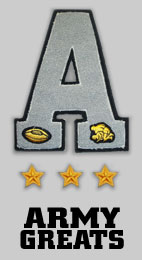
Home
Classes
Coaches
Army Greats
Army Lore
Teams
Of Interest...
About
Submissions
Contact
Newsletter
Credits
Click on small photos
 Cadet will not Lie, Cheat, Steal, or Tolerate Those Who Do Cadet will not Lie, Cheat, Steal, or Tolerate Those Who Do
 USMA at West Point USMA at West Point
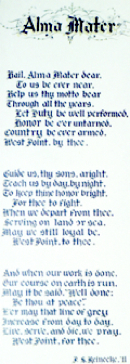 We have changed the wording of our Alma Mater to reflect the fact that our Women Graduates have also given their lives serving this Nation.
We have changed the wording of our Alma Mater to reflect the fact that our Women Graduates have also given their lives serving this Nation.
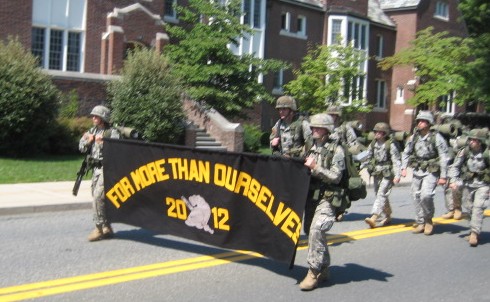 ----- Class of 2012 Motto ------ - "For More Than Ourselves" -Thank you Class of 2012 - for the Honor of Marching with you
The Class of 62 - Can Do ----- Class of 2012 Motto ------ - "For More Than Ourselves" -Thank you Class of 2012 - for the Honor of Marching with you
The Class of 62 - Can Do
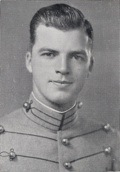 Remember - The Soldiers you will lead Always Come First Remember - The Soldiers you will lead Always Come First
 Motto -- Duty Honor Country Motto -- Duty Honor Country
 The Cadets of West Point
The Cadets of West Point
 They played perhaps Army's Greatest Game. They were the Team that Gave The Most They played perhaps Army's Greatest Game. They were the Team that Gave The Most
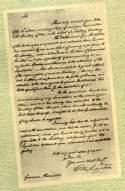 Washington's Letter recommending the establishment of the Academy and the History of West Point
Washington's Letter recommending the establishment of the Academy and the History of West Point

The Oaths We Take
 West Points Medal of Honor Winners West Points Medal of Honor Winners
 Jefferson Hall - the Academy's new Library.
Jefferson Hall - the Academy's new Library.
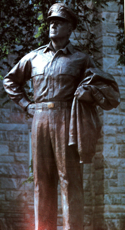 Douglas MacArthur
Douglas MacArthur
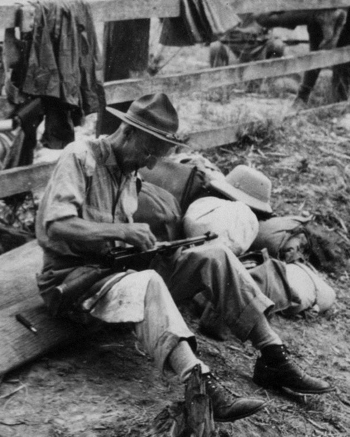
Vinegar Joe Stilwell cleaning his Thompson -The Walkout -Burma 1942
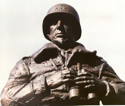 George Patton
George Patton
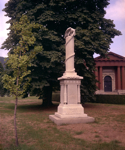 The Monuments of West Point
The Monuments of West Point
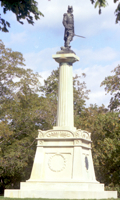 Kosciuszko Monument - Guarding the Hudson ensuring there is no passage of British Man of War
Kosciuszko Monument - Guarding the Hudson ensuring there is no passage of British Man of War
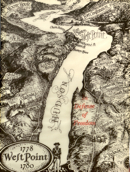 Forts of the Hudson
Forts of the Hudson
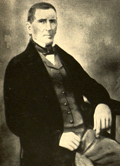
So we'll sing our reminiscences of Benny Havens, Oh!
 Academic Excellence Academic Excellence
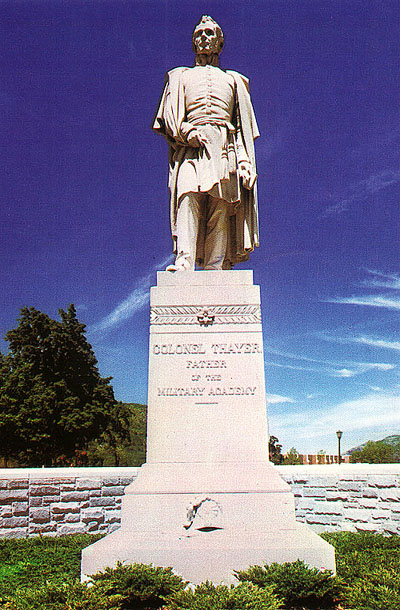 ---- Colonel Thayer ---- Colonel Thayer
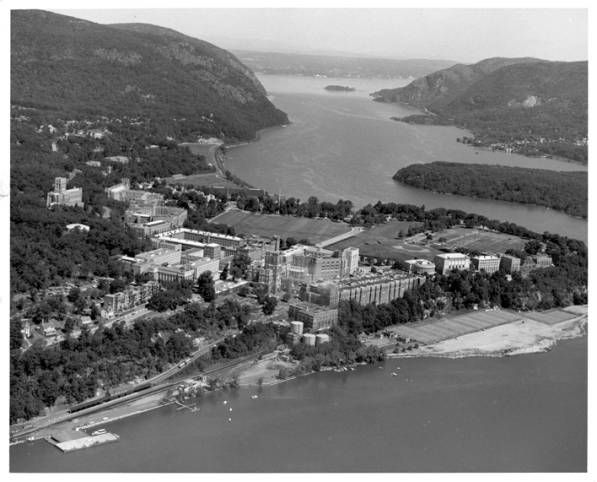 West Point West Point
 Trophy Point Trophy Point
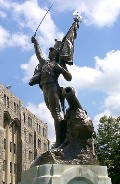 L'Ecole Polytechnique Monument, or The French Monument by Cadets L'Ecole Polytechnique Monument, or The French Monument by Cadets
 Superintendent's Quarters viewed from Thayer Road Superintendent's Quarters viewed from Thayer Road
 Superintendant was not Happy
Black '57
Superintendant was not Happy
Black '57
 Home of the Dean Home of the Dean
 Quarters 104 Quarters 104
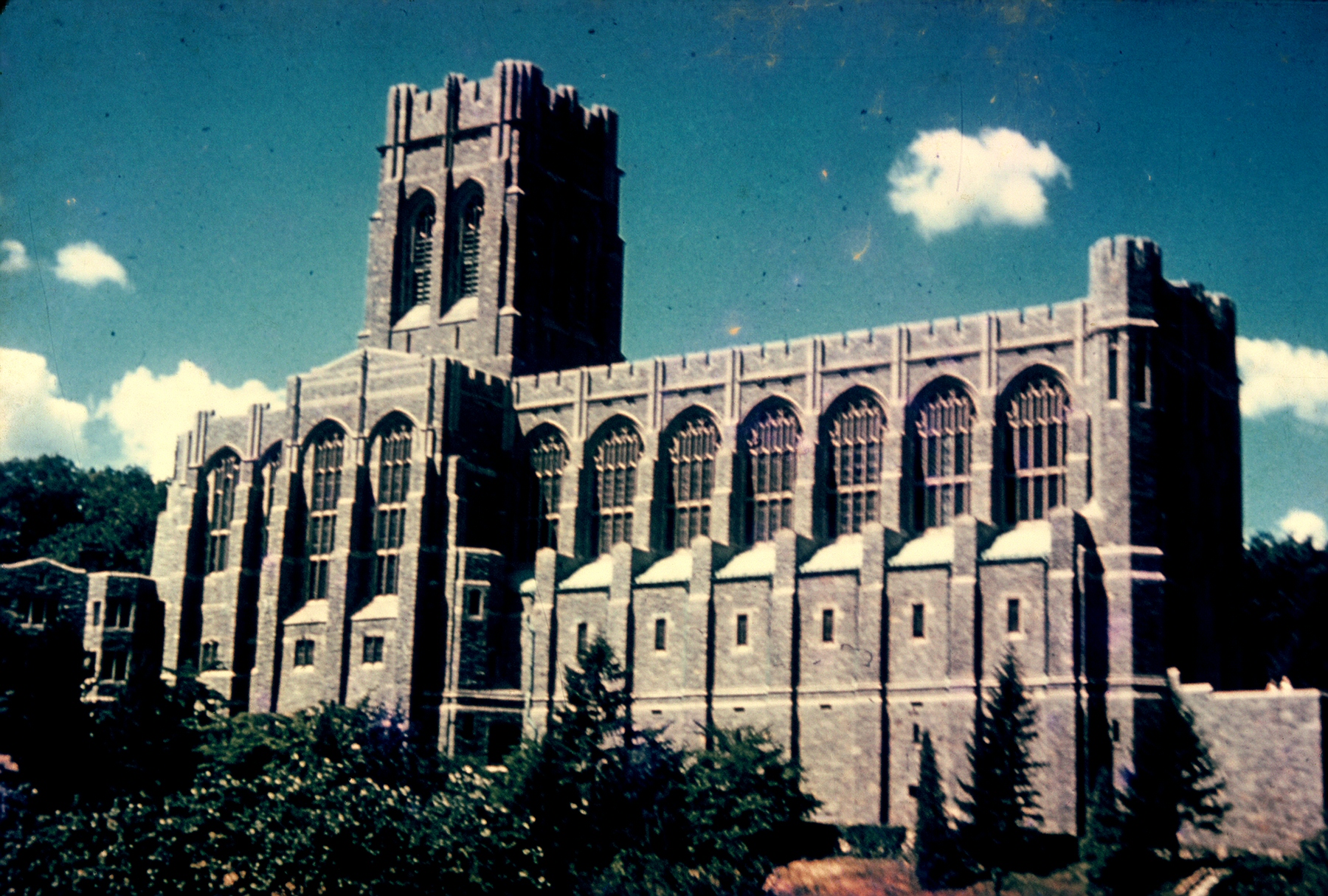 Cadet Chapel Cadet Chapel
 Michie Stadium Michie Stadium
 Arvin Gym Arvin Gym
 Kimsey Athletic Center Kimsey Athletic Center
 Holleder Center Holleder Center
 Washington Monument Washington Monument
 United States Military Academy Band United States Military Academy Band
 Cadet Barracks Cadet Barracks
 Rugby Complex Rugby Complex
 Great Chain Great Chain
 Plain looking toward Washington Hall Plain looking toward Washington Hall
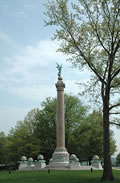 Battle Monument Battle Monument
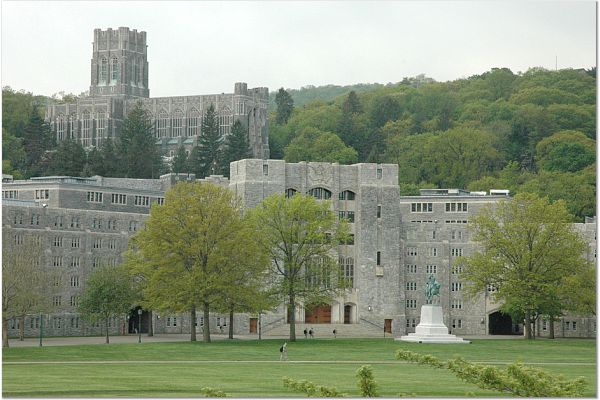 Washington Hall with Cadet Chapel on rocks above. Washington Hall with Cadet Chapel on rocks above.
 Hudson River Hudson River
 Captured Trophies Captured Trophies
 Battle Monument Battle Monument
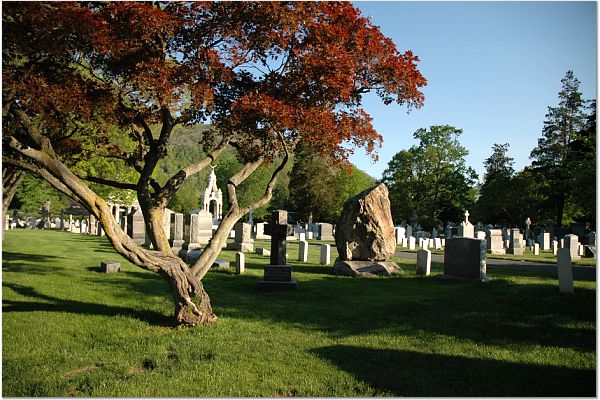 West Point Cemetery West Point Cemetery
 Plain Plain
 Cost to this Nation of Differing Views Cost to this Nation of Differing Views
 Trophy Point -- Our Flag Trophy Point -- Our Flag
 Corps of Cadets Formed in Companies early 1960s Corps of Cadets Formed in Companies early 1960s
 Corps of Cadets Formed in Companies early 1960s Corps of Cadets Formed in Companies early 1960s
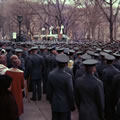 Sending the Army Team off to Beat Navy Sending the Army Team off to Beat Navy
 Army Mule Army Mule
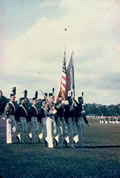 Color Guard Color Guard
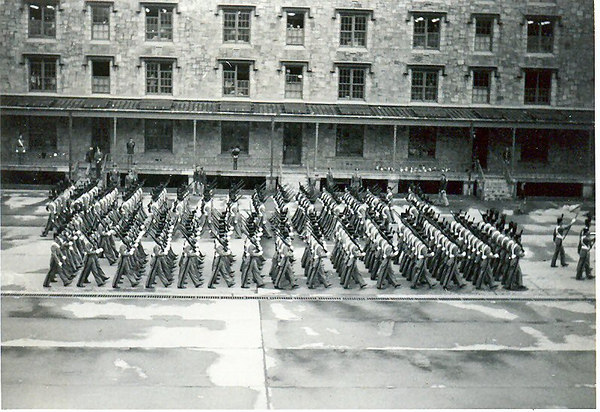
Band Box Review Early 1950's in Central Area
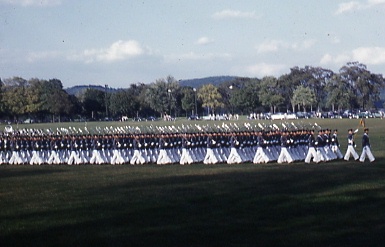 Battalion Mass Early 50's Battalion Mass Early 50's
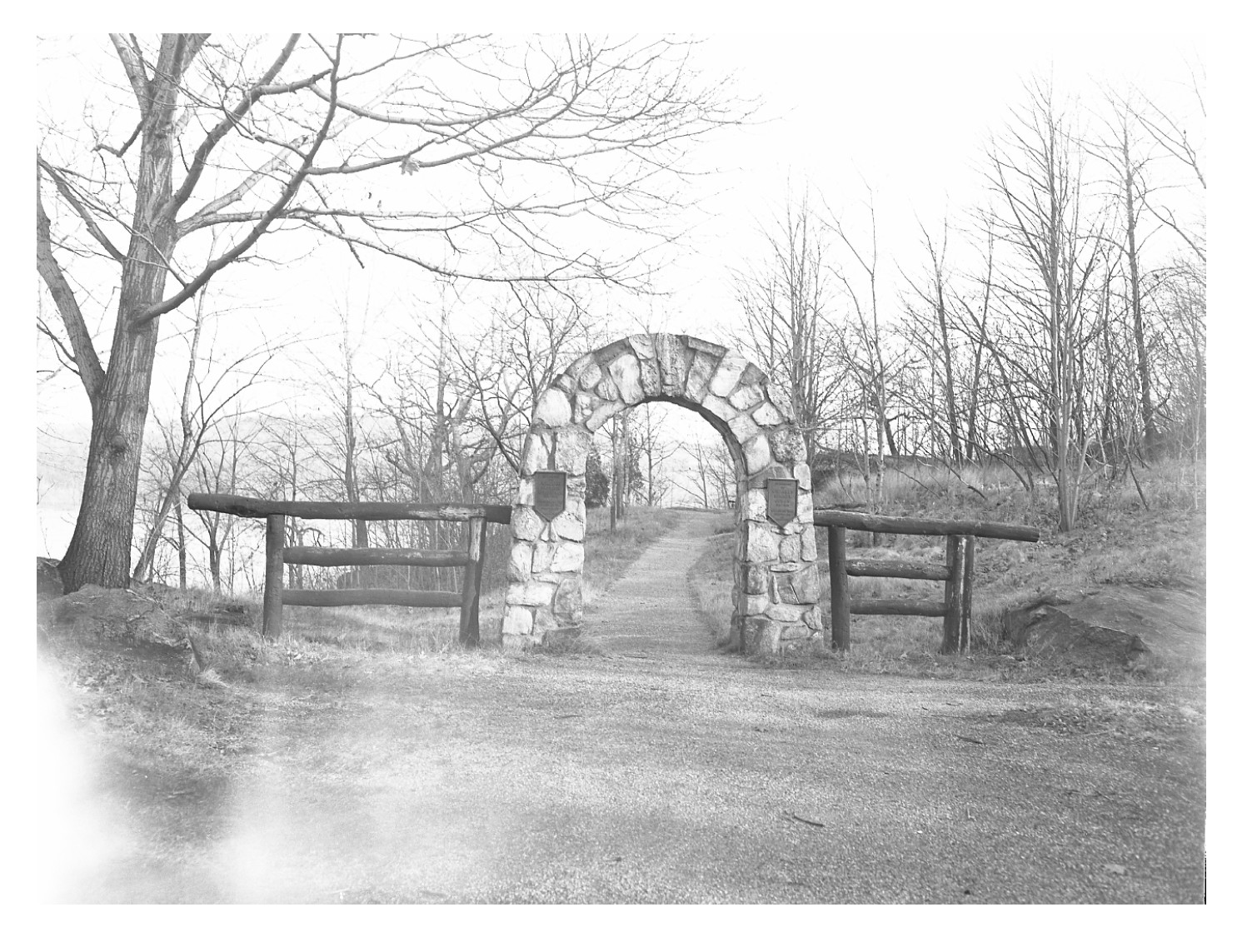 Flirtation Walk Flirtation Walk
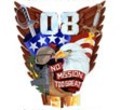
 Arvin Gym Arvin Gym
Duty Honor Country
 Cadet will not Lie, Cheat, Steal, or Tolerate Those Who Do Cadet will not Lie, Cheat, Steal, or Tolerate Those Who Do
 Motto -- Duty Honor Country Motto -- Duty Honor Country
 Remember - The Soldiers you will lead Always Come First Remember - The Soldiers you will lead Always Come First

 Academic Excellence Academic Excellence
 --They played perhaps Army's Greatest Game. They were the Team that Gave The Most --They played perhaps Army's Greatest Game. They were the Team that Gave The Most
 Colonel Thayer Colonel Thayer
 West Point mid 60's West Point mid 60's
 Trophy Point Trophy Point
 L'Ecole Polytechnique Monument, or The French Monument by Cadets L'Ecole Polytechnique Monument, or The French Monument by Cadets
 Superintendent's Quarters viewed from Thayer Road Superintendent's Quarters viewed from Thayer Road
 Cadet Chapel Cadet Chapel
 Michie Stadium Michie Stadium
 Arvin Gym Arvin Gym
 Kimsey Athletic Center Kimsey Athletic Center
 Holleder Center Holleder Center
 Washington Monument Washington Monument
 United States Military Academy Band United States Military Academy Band
 Barracks Barracks
 Rugby Complex Rugby Complex
 Great Chain Great Chain
 Plain looking toward Washington Hall Plain looking toward Washington Hall
 Battle Monument Battle Monument
 Washington Hall with Cadet Chapel on rocks above. Washington Hall with Cadet Chapel on rocks above.
 Hudson River Hudson River
 Captured Trophies Captured Trophies
 Battle Monument Battle Monument
 West Point Cemetery West Point Cemetery
 Plain Plain
 Cost to this Nation of Differing Views Cost to this Nation of Differing Views
 Trophy Point -- Our Flag Trophy Point -- Our Flag
 Corps of Cadets Formed in Companies early 1960s Corps of Cadets Formed in Companies early 1960s
 Corps of Cadets Formed in Companies early 1960s Corps of Cadets Formed in Companies early 1960s
 Sending the Army Team off to Beat Navy Sending the Army Team off to Beat Navy
 Army Mule Army Mule
 Color Guard Color Guard

Band Box Review Early 1950's in Central Area
 Battalion Mass Early 50's Battalion Mass Early 50's
 Flirtation Walk Flirtation Walk
 Cadet will not Lie, Cheat, Steal, or Tolerate Those Who Do Cadet will not Lie, Cheat, Steal, or Tolerate Those Who Do
 Motto -- Duty Honor Country Motto -- Duty Honor Country
 Remember - The Soldiers you will lead Always Come First Remember - The Soldiers you will lead Always Come First
 Academic Excellence Academic Excellence
 They played perhaps Army's Greatest Game. They were the Team that Gave The Most They played perhaps Army's Greatest Game. They were the Team that Gave The Most
 Colonel Thayer Colonel Thayer
 West Point mid 60's West Point mid 60's
 Trophy Point Trophy Point
 L'Ecole Polytechnique Monument, or The French Monument by Cadets L'Ecole Polytechnique Monument, or The French Monument by Cadets
 Superintendent's Quarters viewed from Thayer Road Superintendent's Quarters viewed from Thayer Road
 Cadet Chapel Cadet Chapel
 Michie Stadium Michie Stadium
 Arvin Gym Arvin Gym
 Kimsey Athletic Center Kimsey Athletic Center
 Holleder Center Holleder Center
 Washington Monument Washington Monument
 United States Military Academy Band United States Military Academy Band
 Barracks Barracks
 Rugby Complex Rugby Complex
 Great Chain Great Chain
 Plain looking toward Washington Hall Plain looking toward Washington Hall
 Battle Monument Battle Monument
 Washington Hall with Cadet Chapel on rocks above. Washington Hall with Cadet Chapel on rocks above.
 Hudson River Hudson River
 Captured Trophies Captured Trophies
 Battle Monument Battle Monument
 West Point Cemetery West Point Cemetery
 Plain Plain
 - Cost to this Nation of Differing Views - Cost to this Nation of Differing Views
 Trophy Point -- Our Flag Trophy Point -- Our Flag
 Corps of Cadets Formed in Companies early 1960s Corps of Cadets Formed in Companies early 1960s
 Corps of Cadets Formed in Companies early 1960s Corps of Cadets Formed in Companies early 1960s
 Sending the Army Team off to Beat Navy Sending the Army Team off to Beat Navy
 - Army Mule - Army Mule
 Color Guard Color Guard

Band Box Review Early 1950's in Central Area
 Battalion Mass Early 50's Battalion Mass Early 50's
 Flirtation Walk Flirtation Walk
Click on Photos Below
Please note it takes a couple of hours to update all pages as material is added to this section. You may have to return to the home page to see all of the current links
 Cadet will not Lie, Cheat, Steal, or Tolerate Those Who Do Cadet will not Lie, Cheat, Steal, or Tolerate Those Who Do
 We have changed the wording of our Alma Mater to reflect the fact that our Women Graduates have also given their lives serving this Nation.
We have changed the wording of our Alma Mater to reflect the fact that our Women Graduates have also given their lives serving this Nation.
 ----- Class of 2012 Motto ----- "For More Than Ourselves" Thank you Class of 2012 for the Honor of Marching with you
The Class of 62 ----- Class of 2012 Motto ----- "For More Than Ourselves" Thank you Class of 2012 for the Honor of Marching with you
The Class of 62
 ---------- Class of 2008 --------- ----- Class Crest & Motto ----- "No Mission Too Great" ---------- Class of 2008 --------- ----- Class Crest & Motto ----- "No Mission Too Great"
---- Their Commencement ---- "Here am I; Send me." Thank you Class of 2008 and Please Thank the Men & Women --- the Soldiers you will lead ---
The Class of 62.
 Motto -- Duty Honor Country Motto -- Duty Honor Country
 Remember - The Soldiers you will lead Always Come First Remember - The Soldiers you will lead Always Come First
 Jefferson Hall - the Academy's new Library.
Jefferson Hall - the Academy's new Library.
 Academic Excellence Academic Excellence
 --They played perhaps Army's Greatest Game. They were the Team that Gave The Most --They played perhaps Army's Greatest Game. They were the Team that Gave The Most
 ---- Colonel Thayer ---- Colonel Thayer
 West Point mid 60's West Point mid 60's
 Trophy Point Trophy Point
 L'Ecole Polytechnique Monument, or The French Monument by Cadets L'Ecole Polytechnique Monument, or The French Monument by Cadets
 Superintendent's Quarters viewed from Thayer Road Superintendent's Quarters viewed from Thayer Road
 Cadet Chapel Cadet Chapel
 Michie Stadium Michie Stadium
 Arvin Gym Arvin Gym
 Kimsey Athletic Center Kimsey Athletic Center
 Holleder Center Holleder Center
 Washington Monument Washington Monument
 United States Military Academy Band United States Military Academy Band
 Barracks Barracks
 Rugby Complex Rugby Complex
 Great Chain Great Chain
 Plain looking toward Washington Hall Plain looking toward Washington Hall
 Battle Monument Battle Monument
 Washington Hall with Cadet Chapel on rocks above. Washington Hall with Cadet Chapel on rocks above.
 Hudson River Hudson River
 Captured Trophies Captured Trophies
 Battle Monument Battle Monument
 West Point Cemetery West Point Cemetery
 Plain Plain
 - Cost to this Nation of Differing Views - Cost to this Nation of Differing Views
 Trophy Point -- Our Flag Trophy Point -- Our Flag
 Corps of Cadets Formed in Companies early 1960s Corps of Cadets Formed in Companies early 1960s
 Corps of Cadets Formed in Companies early 1960s Corps of Cadets Formed in Companies early 1960s
 Sending the Army Team off to Beat Navy Sending the Army Team off to Beat Navy
 - Army Mule - Army Mule
 Color Guard Color Guard

Band Box Review Early 1950's in Central Area
 Battalion Mass Early 50's Battalion Mass Early 50's
 Flirtation Walk Flirtation Walk

 Arvin Gym Arvin Gym
Duty Honor Country
 Cadet will not Lie, Cheat, Steal, or Tolerate Those Who Do Cadet will not Lie, Cheat, Steal, or Tolerate Those Who Do
 Motto -- Duty Honor Country Motto -- Duty Honor Country
 Remember - The Soldiers you will lead Always Come First Remember - The Soldiers you will lead Always Come First

 Academic Excellence Academic Excellence
 --They played perhaps Army's Greatest Game. They were the Team that Gave The Most --They played perhaps Army's Greatest Game. They were the Team that Gave The Most
 ---- Colonel Thayer ---- Colonel Thayer
 West Point mid 60's West Point mid 60's
 Trophy Point Trophy Point
 L'Ecole Polytechnique Monument, or The French Monument by Cadets L'Ecole Polytechnique Monument, or The French Monument by Cadets
 Superintendent's Quarters viewed from Thayer Road Superintendent's Quarters viewed from Thayer Road
 Cadet Chapel Cadet Chapel
 Michie Stadium Michie Stadium
 Arvin Gym Arvin Gym
 Kimsey Athletic Center Kimsey Athletic Center
 Holleder Center Holleder Center
 Washington Monument Washington Monument
 United States Military Academy Band United States Military Academy Band
 Barracks Barracks
 Rugby Complex Rugby Complex
 Great Chain Great Chain
 Plain looking toward Washington Hall Plain looking toward Washington Hall
 Battle Monument Battle Monument
 Washington Hall with Cadet Chapel on rocks above. Washington Hall with Cadet Chapel on rocks above.
 Hudson River Hudson River
 Captured Trophies Captured Trophies
 Battle Monument Battle Monument
 West Point Cemetery West Point Cemetery
 Plain Plain
 - Cost to this Nation of Differing Views - Cost to this Nation of Differing Views
 Trophy Point -- Our Flag Trophy Point -- Our Flag
 Corps of Cadets Formed in Companies early 1960s Corps of Cadets Formed in Companies early 1960s
 Corps of Cadets Formed in Companies early 1960s Corps of Cadets Formed in Companies early 1960s
 Sending the Army Team off to Beat Navy Sending the Army Team off to Beat Navy
 - Army Mule - Army Mule
 Color Guard Color Guard

Band Box Review Early 1950's in Central Area
 Battalion Mass Early 50's Battalion Mass Early 50's
 Flirtation Walk Flirtation Walk
 Cadet will not Lie, Cheat, Steal, or Tolerate Those Who Do Cadet will not Lie, Cheat, Steal, or Tolerate Those Who Do
 Motto -- Duty Honor Country Motto -- Duty Honor Country
 Remember - The Soldiers you will lead Always Come First Remember - The Soldiers you will lead Always Come First
 Academic Excellence Academic Excellence
 --They played perhaps Army's Greatest Game. They were the Team that Gave The Most --They played perhaps Army's Greatest Game. They were the Team that Gave The Most
 ---- Colonel Thayer ---- Colonel Thayer
 West Point mid 60's West Point mid 60's
 Trophy Point Trophy Point
 L'Ecole Polytechnique Monument, or The French Monument by Cadets L'Ecole Polytechnique Monument, or The French Monument by Cadets
 Superintendent's Quarters viewed from Thayer Road Superintendent's Quarters viewed from Thayer Road
 Cadet Chapel Cadet Chapel
 Michie Stadium Michie Stadium
 Arvin Gym Arvin Gym
 Kimsey Athletic Center Kimsey Athletic Center
 Holleder Center Holleder Center
 Washington Monument Washington Monument
The material below this point is a site a work area.


Page 2
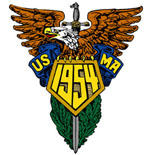 The '54 Crest
The '54 Crest
 General MacArthur stated it would take
General MacArthur stated it would take "at least 10 years" to return Army Football to Respectability
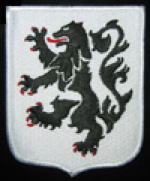 28th Infantry Regiment Black Lion Award is intended to go to the person on his team "who best exemplifies the character of Don Holleder: leadership, courage, devotion to duty, self-sacrifice, and - above all -
28th Infantry Regiment Black Lion Award is intended to go to the person on his team "who best exemplifies the character of Don Holleder: leadership, courage, devotion to duty, self-sacrifice, and - above all - an unselfish concern for the team ahead of himself."
 General George Patton
General George Patton "The Army moves as a team, eats as a team, and fights as a team."
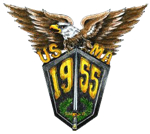 The '55 Crest
The '55 Crest
 They played perhaps Army's Greatest Game. They played perhaps Army's Greatest Game.They were the Team that Gave The Most
 Don Hollender Remember - The Soldiers you will lead Always Come First
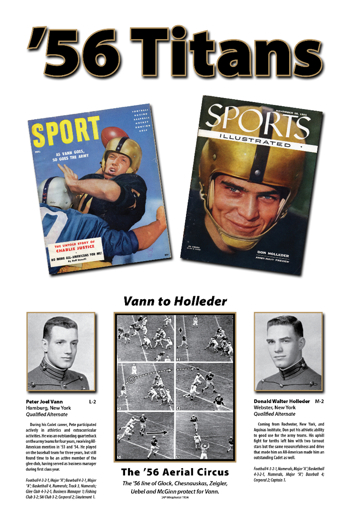 Vann and Holleder Vann and Holleder
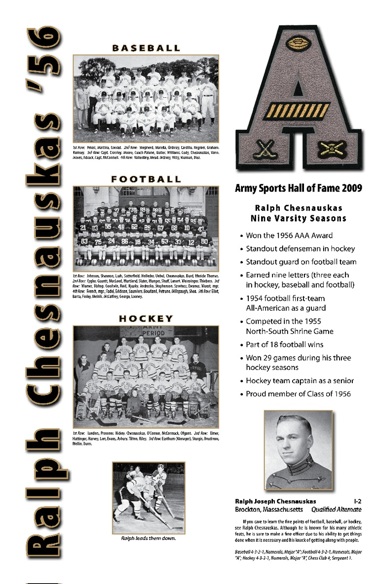 9 Army A's 9 Army A's
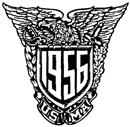 The '56 Crest
The '56 Crest
 The '57 Crest
The '57 Crest
 Can Do
Can Do
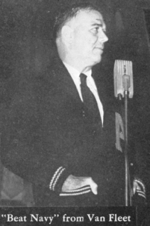 Gen Van Fleet addressing the Corps prior to the Navy Game
Gen Van Fleet addressing the Corps prior to the Navy Game
 Constructed under supervision of Jay Gould "54 and the Ord Dept from a German Rocket Gun captured at Kasserine Pass. First used in the Duke Game.
Constructed under supervision of Jay Gould "54 and the Ord Dept from a German Rocket Gun captured at Kasserine Pass. First used in the Duke Game.
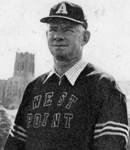 COL "Red" Reeder granted the Cheerleaders Corps Squad status to obtain financial support for their spirit-inducing initiatives.
COL "Red" Reeder granted the Cheerleaders Corps Squad status to obtain financial support for their spirit-inducing initiatives.
 Bob Mischak - - It should be pointed out that Bob was an All American selection, but is not recognized by the Academy as such because of the organization which selected him. Bob Mischak - - It should be pointed out that Bob was an All American selection, but is not recognized by the Academy as such because of the organization which selected him.
 Ubel scores 3 Times against Navy - Vann's facking results in Peter getting tackled - #10 on the ground behind Ubel
Ubel scores 3 Times against Navy - Vann's facking results in Peter getting tackled - #10 on the ground behind Ubel
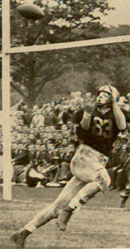 Vann to Sisson
Vann to Sisson
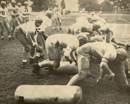 Army's B Squad
Army's B Squad
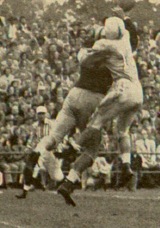 Vann to Mischak. Vann to Mischak.
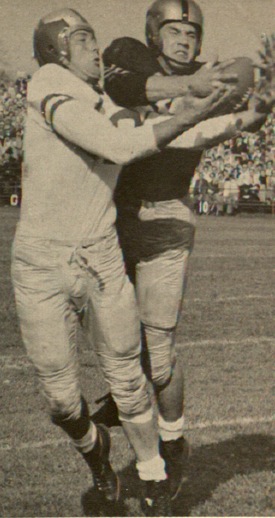 Uebel Intercepts Uebel Intercepts
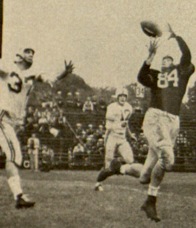 Cody to Don Holleder Cody to Don Holleder
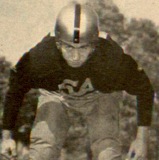 Lasley Lasley
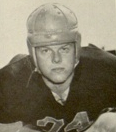 Frank Hicks Frank Hicks
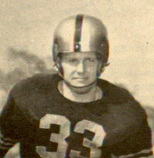 Burd Burd
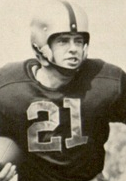 Bill Purdue Bill Purdue
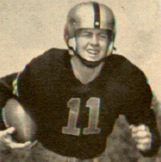 Cody Cody
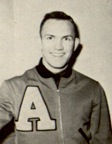 Meador Mgr Meador Mgr
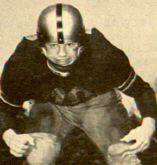 Ron Melnick Ron Melnick
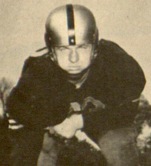 Ralph Chesnauskas Ralph Chesnauskas
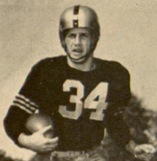 Pat Uebel Pat Uebel
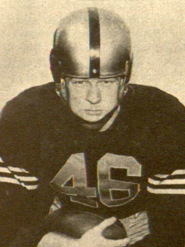 Tommy Bell Tommy Bell
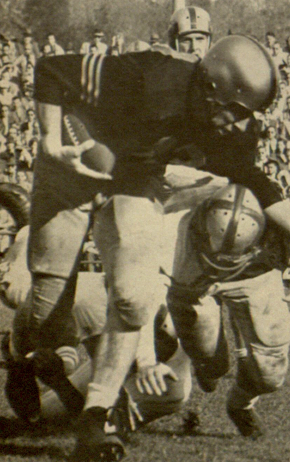 Sisson headed for another score Sisson headed for another score
 Peter Vann stuffs the ball in Jerry's gut Peter Vann stuffs the ball in Jerry's gut
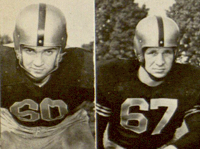 Leroy Lunn & Jerry Lodge Leroy Lunn & Jerry Lodge
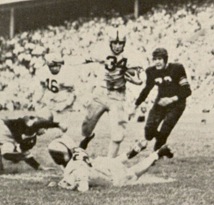 Uebel after taking the handoff from Hagan
Uebel after taking the handoff from Hagan
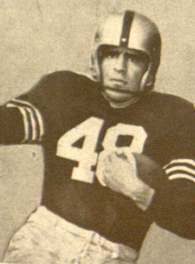 Attaya - Army's Fullback
Attaya - Army's Fullback
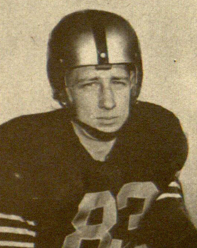 Sisson - one of 3 Great Ends
Sisson - one of 3 Great Ends
 Bob Mischak Bob Mischak
 Ralph Chesnauskas Ralph Chesnauskas
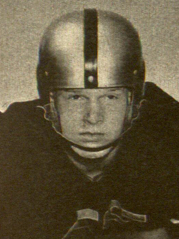 Bob Farris Bob Farris
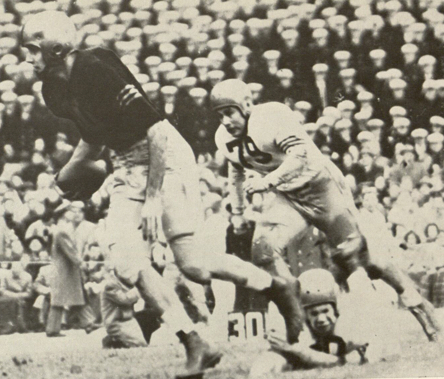 Vann moving out of the pocket
Vann moving out of the pocket
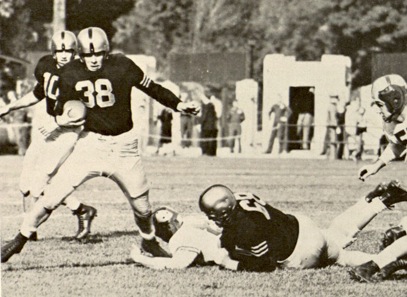 Peter Vann 10, Billy Chance 38, Herdman 68
Peter Vann 10, Billy Chance 38, Herdman 68
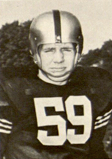 Ken Kramer Ken Kramer
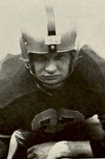 Joe Lapchick Joe Lapchick
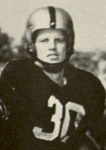 Kirk Cockrell Kirk Cockrell
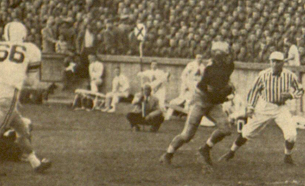 Lodge going down tosses to Paul Schweikert for score. Lodge going down tosses to Paul Schweikert for score.
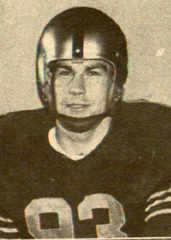 Dick Zeigler Dick Zeigler
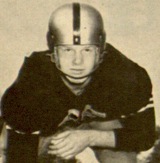 Bob FarrisPlayed the 2d half of the Navy Game blind in one eye. Bob FarrisPlayed the 2d half of the Navy Game blind in one eye.
 Pat Uebel Pat Uebel
 Tommy Bell Tommy Bell
 Peter Vann Peter Vann
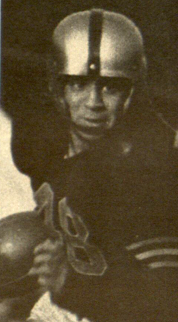 Freddie Attaya Freddie Attaya
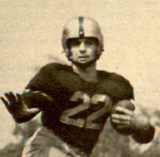 Mike Zeigler Mike Zeigler
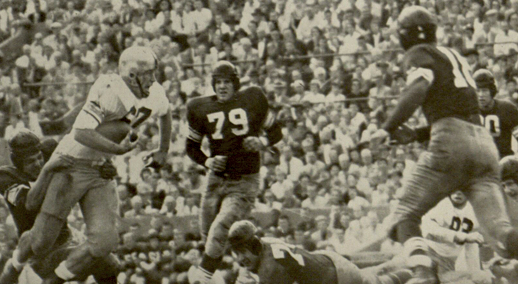 Jerry Lodge wearing #67, playing fullback. Jerry Lodge wearing #67, playing fullback.
 Johnny Wing Johnny Wing
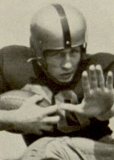 Lowell Sisson Lowell Sisson
 Norm Stephen Norm Stephen
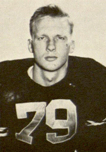 Jack Krause Jack Krause
 Dick Ziegler Dick Ziegler
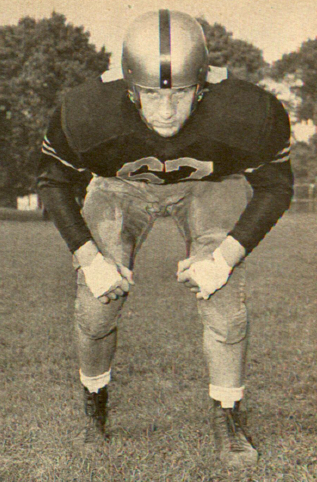 Jerry Lodge Jerry Lodge
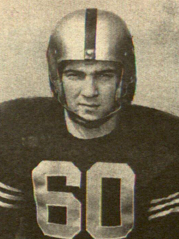 Leroy Lunn Leroy Lunn
 Norm Stephen Norm Stephen
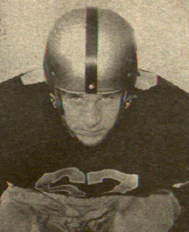 Jerry Lodge Jerry Lodge
 Corps of Cadets for Navy Game Corps of Cadets for Navy Game
 Can Do
Can Do
 General MacArthur stated it would take
General MacArthur stated it would take "at least 10 years" to return Army Football to Respectability
 General George Patton
General George Patton "The Army moves as a team, eats as a team, and fights as a team."
 Don Hollender Remember - The Soldiers you will lead Always Come First
 The '54 Crest
The '54 Crest
 The '55 Crest
The '55 Crest
 28th Infantry Regiment Black Lion Award is intended to go to the person on his team "who best exemplifies the character of Don Holleder: leadership, courage, devotion to duty, self-sacrifice, and - above all -
28th Infantry Regiment Black Lion Award is intended to go to the person on his team "who best exemplifies the character of Don Holleder: leadership, courage, devotion to duty, self-sacrifice, and - above all - an unselfish concern for the team ahead of himself."
 They played perhaps Army's Greatest Game. They played perhaps Army's Greatest Game.They were the Team that Gave The Most
 The '56 Crest
The '56 Crest
 The '57 Crest
The '57 Crest
|
1912 Football Team
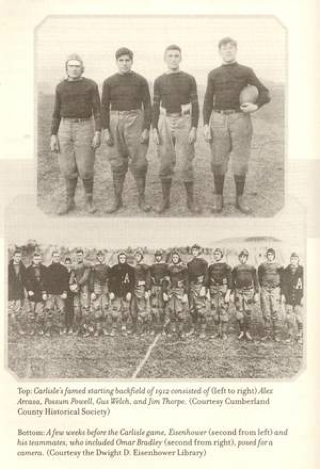
The Carlisle Backfield (top) and the 1912 Army team (bottom). Dwight Eisenhower, second from left.
|
The Greastest Grudge Game Ever
By: John Hall in State College Magazine 12/12/2009
November 9, 1912 - Collum Field, West Point, N.Y.
The sky was ugly. The temperature hovered around freezing all day, and black angry clouds were swirling over the Hudson River, threatening at any minute to drop a torrent of sleet on the crowd that had gathered to watch the greatest grudge game in football history.
On one side of the field, in black and gold uniforms, stood the mighty Cadets of Army. For years Harvard, Yale and Princeton had dominated the college gridiron, and they were called the Big Three. But over the past couple of seasons, through sheer guts and determination, Army had kicked down the door of that exclusive club and taken a seat at the table, and now people talked about the Big Four.
Across the field in red and white stood another upstart team determined to enter the ranks of the elite. But where Army had bludgeoned their way in, this team was determined to dance their way in. They were the Carlisle Indian Industrial School. Their official nickname was the Pirates, but everyone called them the Indians.
The Indian School at Carlisle, Pa., was the brainstorm of Richard Henry Pratt, an American Army officer who led the African-American "Buffalo Soldiers" in genocidal warfare against Native-American Indians. Most white Americans at the time were comfortable with the notion that the Indians either had to be exterminated or turned into a new type of slave. But Pratt felt that there had to be a better way. First he convinced the Federal government to give him the school. Then he convinced the Indians that their children would have a better chance of survival if they learned to read and write as well as the white man.
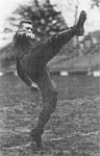
Eisenhower in play action
|
Soon the Indians learned that they could also compete with the white man at his own game of football. The previous year Carlisle had beaten Pitt, Penn and Harvard. Going into the game at West Point they were 9-0-1. They were looking at nothing less than the national championship, and no one wanted it more than the Carlisle coach, Glenn Scobey "Pop" Warner. A brilliant strategist, he was also football's first great innovator. In 1894 Warner was playing left guard for Cornell when their head coach, Marshall Newell, announced that he would be gone for a week to help his alma mater, Harvard, prepare for their annual showdown with Yale. Warner was named interim head coach and, seizing the opportunity to turn a game of brute force into a game of poetry and chess, he devised a trick play. Locked in a scoreless tie with Williams College late in the fourth quarter, Warner whispered "Number 39" in his quarterback's ear. The quarterback took the ball and swung his arms toward the left halfback, and the whole team began sprinting left, except Warner. He took two steps back, pulled the ball out of the quarterback's hands, and began running right into an open field. He was tackled from behind and fumbled the ball just short of the goal line. He failed to win the game, but had just invented the reverse.
When he took the coaching job at Carlisle, he found the Indians smaller than most college football players, but he also found them quick and athletic. He discovered ways to capitalize on this. He was the first coach to have backs start from a three-point stance and he invented what was called the Indian block, but today everyone calls it the cross body block. He also invented the wingback and single-wing formation. Then, in 1907, college football legalized the forward pass.
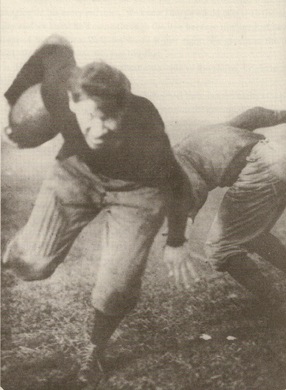
Pennsylvania football icon, Jim Thorpe
|
At the time quarterbacks hurled the ball end-over-end, threw it like a shot put, or lobbed it underhand like a softball. Predictably, it lost all accuracy after about five yards. Warner played with the ball all summer, looking for a better way. Then when practice started in 1907 he called his backs aside. "I want you to practice this," he said. He then spread his hand, placed the stitches along his fingers and wrapped his thumb around the other side of the ball. "Hold it like this, bring it up behind your head, and when you bring it forward put a spin on it, and then you will be able to throw it with pinpoint accuracy for 30 or 40 yards." Warner had just invented the technique for the forward pass.
Now Warner, in his quest for the 1912 National Championship, had two things going for him. One was a new formation he had invented. The other was Jim Thorpe. Four months earlier, Thorpe was in Stockholm, Sweden, where he won the Olympic pentathlon and decathlon. When he was presented with the gold medals, Gustav, the King of Sweden, leaned forward and told him, "Sir, you are the greatest athlete in the world." Thorpe simply replied, "Thanks, King."
The American press agreed with the king. In the four months since then, Thorpe had received more coverage than Ty Cobb, Honus Wagner, and heavyweight boxing champion Jack Johnson. His reputation was not overrated. He could run, he could pass, he could kick. His high jumping and broad jumping ability enabled him to literally run over players, leaving bloody cleat marks on their thighs, torso and shoulders. During a game on September 28 against Dickinson, Thorpe had picked up a bungled snap in his own end zone and outran everyone for a 105-yard touchdown. The previous year at Forbes Field he had punted against Pittsburgh from deep in his own territory. Thorpe managed to race down the field, catch his own punt and run it in for a touchdown.
But on the other side of Collum Field this November day, there was a blue-eyed hardscrabble kid from Kansas who had plans of his own. It was only his first year as a starter, but he was already considered one of the hardest-running halfbacks and hardest-hitting linebackers in college football. He was determined to cement his reputation forever by using his bone-crushing tackles to put Jim Thorpe in the hospital. The kid's name was Dwight Eisenhower.
Warner was taking no chances; he had been playing the race card for weeks. "These are the grandsons of the men who killed your grandfathers and raped your grandmothers at Wounded Knee," he told his players in the pregame pep talk. "Today they will have their revenge. Today will be the day to make every Indian in America proud." However, it is unlikely that Thorpe found much inspiration from such talk. In the first place, prodigies like Thorpe usually transcend petty prejudice. In the second place, Thorpe didn't have any grandfathers at Wounded Knee. His one grandfather was Irish and his own father prided himself on a reputation as a hard-drinking, hard-fighting, quick-tempered "Irishman" His other grandfather was French and his mother Charlotte Vieux was a devout Roman Catholic, as was Thorpe his entire life. This made him a lightning rod for three of what were probably the top five prejudices in America at the time. Germans were securely in first place ahead of blacks, then, in no particular order, came Irish, Indians and Catholics.
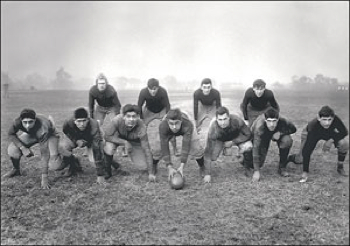
Carlisle Team
|
At 3 o'clock on that gray and windy afternoon, Thorpe took the opening kickoff and returned it for 13 yards. Then he walked over to the huddle where Carlisle quarterback Gus Welch told the team it was time to unleash Warner's secret weapon. The Indians lined up in their standard power formation, two halfbacks and a fullback behind the quarterback. Thorpe then moved left and closer to the line, where he lined up in a three-point stance outside the left tackle. Alex Arcasa did the same thing on the right. Nobody had ever seen this before, but anyone today would recognize it for what Warner had already named it: the double wing formation.
During the first half, the Indians ran at Army out of this new formation, using a variety of reverses, double reverses and fake reverses. It seemed that at least three Indian backs had to touch the ball on every play. Years later, after he retired as president, Eisenhower recalled that one of the most awesome things he had ever seen in his life was Jim Thorpe running at him out of the double wing. But no one was more impressed by Warner's innovative formation than a New York sportswriter named Walter Camp. In 1876 Camp had taken an English game called rugby and revised it - adding set downs, a line of scrimmage, and a few other changes. When he was done he had invented American football. Now he was the most respected sportswriter in America. He alone selected the National Champion and the All-America Team, and no one questioned his judgment. But in all his years as player, coach and writer, he had never seen anything like this: it didn't look like football; it was more like a circus, or basketball on grass.
Carlisle was clearly outplaying Army, but the Cadets, through sheer tenacity and luck, entered the locker room at halftime with Carlisle leading by only a point, 7-6. However, with the new formation, the greatest athlete in the world, and the frenzy of revenge that Warner had instilled in his team, Eisenhower knew that the game was about to get out of hand, unless Thorpe was eliminated. Eisenhower called another linebacker, Leland Hobbs, over to a corner where he laid out his battle plan. Hobbs was to watch Eisenhower for a signal. Then Eisenhower, with all the force he could muster, would run directly into Thorpe's chest, while Hobbs would blindside Thorpe's knees as hard as he could.
The second half did not start well for Army. On Carlisle's first possession of the half, Welch pitched the ball to Arcasa, who ran behind Thorpe and tackle Joe Guyon. Army captain "Leland Devore" had a bead on Arcasa, but he was knocked down by Thorpe and Guyon, while Arcasa ran around him for a touchdown. On the ensuing kickoff a humiliated and enraged Devore ignored the play and blindsided Guyon like a runaway freight train. Devore was immediately ejected for unsportsmanlike conduct. With the Army captain out, Eisenhower realized that he had to do something soon. He noticed that on first down Thorpe invariably ran the ball for Carlisle, so on the next series of downs he gave the signal to Hobbs. The two hit Thorpe as planned and spectators later said that the collision sounded like a pair of two-by-fours being slammed together. All three players went down. Hobbs got up first, then Eisenhower, but Thorpe stayed down. Eisenhower, thinking his plan had worked, began celebrating, but then the big Indian got up and walked to the huddle.
Eisenhower was now more determined than ever. A few plays later he and Hobbs tried it again. But like all great players, Thorpe had an instinct for the game, and at this point he demonstrated one of his less-known but highly impressive athletic skills: an ability to go from full speed to a standstill in a single step. So Thorpe, sprinting with the ball, stopped suddenly, watched as the two Army linebackers collided in front of him, and then ran around them for a few more yards. Eisenhower and Hobbs were barely conscious. Hobbs got to his feet first and staggered to the bench for medical assistance. Eisenhower got up but could hardly walk. He pleaded to stay in the game, but his coach, Ernest Graves, ordered him to the bench. Without Devore, without Hobbs, and without Eisenhower, the game turned into a rout and Carlisle won 27-6. In the locker room, Devore told reporters: "That Indian is the greatest player I have ever stacked up against. He is super-human. There is nothing he can't do."
That night as the Indians rode the train back to Manhattan, Walter Camp walked into their car. He told them that they might indeed be the best team in the nation, and he congratulated Thorpe, calling him the most brilliant player he had ever seen. Then the man who invented American football turned to Warner and told him that after today the game would never be played the same again.
The following week Eisenhower, still limping, suited up for a game against Tufts. As he carried the ball and tried to surge forward for an extra yard, a Tufts player grabbed his ankle and twisted his leg as hard as he could. Something popped and Eisenhower flopped around the field like a fish on dry land. He left the field on a stretcher and never played another down. He finished his football career at West Point as a cheerleader. Editor's Note - Eisenhower Coached the Cullum or Plebe Team

Pop Warner
|
Pop Warner's hopes for a national championship were shattered a week later in Philadelphia when Carlisle was defeated by Penn, 34-26. The following week they beat Springfield, and then went to Providence to play Brown on Thanksgiving Day. It was now Thorpe's turn for his luck to run out. On the day before Thanksgiving, Thorpe participated in his last practice ever as a Carlisle player. A local sportswriter, Roy Johnson, came to the practice looking for an angle on a story. While watching the workout he recognized Charley Glancy, a former professional baseball coach who had also come to watch the practice. As the two were talking, Glancy suddenly interrupted Johnson: "I know that guy," he said, pointing to Thorpe. "He played for me a couple of years ago." Johnson, stunned, was on the story like a dog on a bone. Jim Thorpe had received a salary for playing baseball, making him retroactively ineligible for the Olympics. The International Olympic Committee stripped him of his championships and forced him to return his medals. In 1982, almost 30 years after Thorpe's death, the committee completed the farce by reinstating him. It mattered little. Thorpe's reputation had been earned on the playing field and nothing could tarnish it.
|
|


 General MacArthur stated it would take
General MacArthur stated it would take  28th Infantry Regiment
28th Infantry Regiment 
 They played perhaps Army's Greatest Game.
They played perhaps Army's Greatest Game.


























































 General MacArthur stated it would take
General MacArthur stated it would take 


 28th Infantry Regiment
28th Infantry Regiment  They played perhaps Army's Greatest Game.
They played perhaps Army's Greatest Game.



































 Cadet Barracks
Cadet Barracks

























